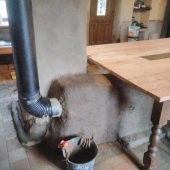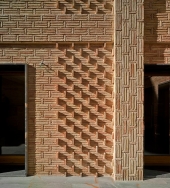
 5
5




Cedric

 7
7




Proudly presenting RocketMassHeaters.com
A good starting point to all RMH research
How Permies.com works
 4
4





 10
10




For all your Montana Masonry Heater parts (also known as) Rocket Mass heater parts.
Visit me at
dragontechrmh.com Once you go brick you will never go back!
 5
5




Benjamin Dinkel wrote:Hi Cedric,
I don’t know how hot the bell outside gets. I’m sure some of the Permies with a bell in their house can answer that.
You could also put insulation between the bell and the stair.
Or maybe insulate a bigger part on the inside of the bell around where it will touch with some super wool.
 3
3




Benjamin Dinkel wrote:Hi
Is it structurally necessary that the ladder/staircase touches the bell? Does the fireplace support the stairs?
Could you make the bell slightly smaller, leaving a gap?
Cedric
 4
4




 2
2




Ned Harr wrote:Maybe look into building a "Russian fireplace" or a pizza oven or something, where the entire bell is covered with firebrick and cob. A Russian fireplace is similar to a RMH in design, only I think it is arranged a bit more vertically. (Sorry, I don't have more info at the moment; I am not an expert in any kind of fireplace! But hopefully this gives you a starting point in your research.)
If you plug "russian fireplace" into DuckDuckGo and look at images, many of them have stairs and other furniture built right into the side: https://duckduckgo.com/?t=ffab&q=russian+fireplace&atb=v439-1&ia=images&iax=images
I would still check with an expert, but at first glance it seems the Russian fireplace design would make it safe to attach a wooden structure directly to the outside and could work well for the configuration in your photo.
Cedric
 4
4




thomas rubino wrote:Hi Cedric;
If you build a double skin bell.
The IBC International Building Code says a 4" clearance to flammable surfaces for a masonry stove with a double skin.
Or use superwool to insulate if you are closer.
Cedric
 2
2




Scott Weinberg wrote:
Benjamin Dinkel wrote:Hi Cedric,
I don’t know how hot the bell outside gets. I’m sure some of the Permies with a bell in their house can answer that.
You could also put insulation between the bell and the stair.
Or maybe insulate a bigger part on the inside of the bell around where it will touch with some super wool.
Thoughts-
Tom said it to, utilization of or about the super wool, but...to the first question.
Temp-
In my opinion having the bell much above 200-225 degrees, is approaching trying to do to much with to little. In other words if your space is not heating up as much as you want, and you try to get it done by super heating your bell, and some point the whole efficiency is getting reduced. Remember if you have a efficient fire as all of Peter's designed stoves are, then you need to concentrate on maximum heat collection into the bell, This range of temp can go well? Up and up. But at sometime the flue temp gets higher and higher, where the answer really lies within? did we make a stove large enough for the desired heat.
All of these figures have been published before.
Most of these figures have shown the differences in 4-5-6-7" stoves with a occasional 8" monster And I think most would agree that in the coldest time of winter if a fire would be once or twice in the morning and once in the evening, gives a great deal of flexibility, such as 1 and 1 firing, instead of 2 in morning 1 evening, down to may just one firing a day and so on. So many options. But less options if your stove is to small or to large. ( part of the fun is to calculate this)
The real point I am making, is this.
*Your stove should be able to do what you want without getting excessively hot.
*Insulation, can help as pointed out, in really tight spots.
*Flexibility is a huge plus when sized right
*all of the above is much simpler than a complex Russian type stove
Best of success!
Cedric
 4
4




Cedric Noussan wrote:
the size of the combustion unit for this project is determined by the existing flue pipe and cannot be modified, it is a rectangular pipe 15cmx 30cm not insulated, therefore a combustion unit of 20cm, quite a dragon!
I will have to heat a space of about 100m² medium insulated with minimum external winter temperatures of about -4.
the flue pipe being about 6m long what isa will I have to calculate?
 2
2




Scott Weinberg wrote:
Cedric Noussan wrote:
the size of the combustion unit for this project is determined by the existing flue pipe and cannot be modified, it is a rectangular pipe 15cmx 30cm not insulated, therefore a combustion unit of 20cm, quite a dragon!
I will have to heat a space of about 100m² medium insulated with minimum external winter temperatures of about -4.
the flue pipe being about 6m long what isa will I have to calculate?
on the flue-
6.9 " x 11.8" or 81.4 inch squared. or 450 Cm squared ( 15 x 30 cm) I will let others step in here, but a couple of things,
1) I don't think with something this none square should be considered to the be of the max square inches or Cm's An example would be a 7" square would not be considered a larger size than a 7" round
2) I think it should be figured out or calculated the capabilities of your existing flue pipe.
First thing first!
Cedric
 5
5




regards, Peter
 4
4




Peter van den Berg wrote:In order to compare a rectangular chimney with a circular one, there's a simple calculation method I've found here in the Netherlands. It goes like this: 2xLxW/(L+W)=FD. Where L is length, W is width and FD is fictional diameter. So for the 15x30 cm chimney: 2x15x30/(15+30)=20 cm.
When applied to a square, you'll see that the result is a fictional diameter which is the same as one side of the square. Which is correct, the square is larger in cross section area but has more surface area as compared to the circle and the corners are infamous friction areas.
Just attempting to transpose it to inches: 15x30 is roughly 6"x12". In that case the formula is 2x6x12/(6+12)=8", very close to the 20 cm above.
So Cedric, you could go for a 20 cm system, or somewhat smaller. Keep in mind, the Shorty core is a bit different in that it delivers less power in the same time frame as the first generation batchrocket. That's because the construction of the core is done in such a way that the combustion rate is limited. So, in order to avoid startup trouble, the bell should be 10 to 15% smaller than the table on the website indicates. And it's almost required to install an effective bypass. Are you planning for a straight core or a sidewinder? Both are possible and proven to work.
Cedric
 2
2




Cedric Noussan wrote:
thanks for the detailed answer, i really appreciate it!
so since the chimney is very encrusted i will opt for a 19cm system
also since one part is not insulated and it is not possible to do so, how should i count this in the isa calculations? the absorbent surface divided by 2?
regards, Peter

|
Morgan Freeman narrated the birth and life of this tiny ad:
The new gardening playing cards kickstarter is now live!
https://www.kickstarter.com/projects/paulwheaton/garden-cards
|



-Completed-steel-RMH-(Notice-space-for-airflow-under-and-up-the-back-side-of-the-external-mass.).jpg)



